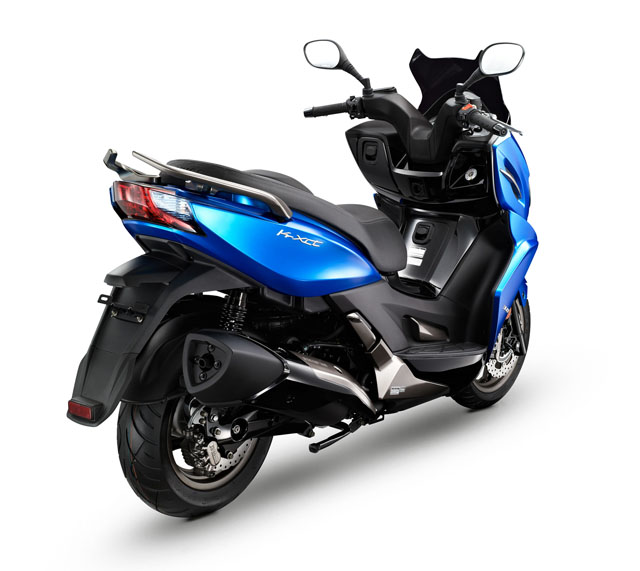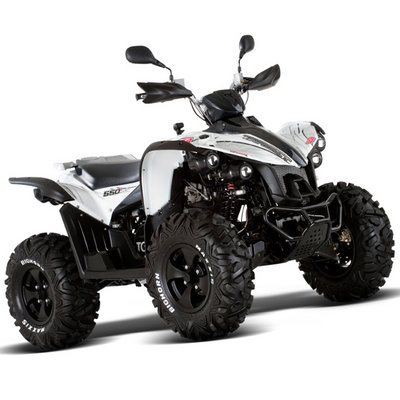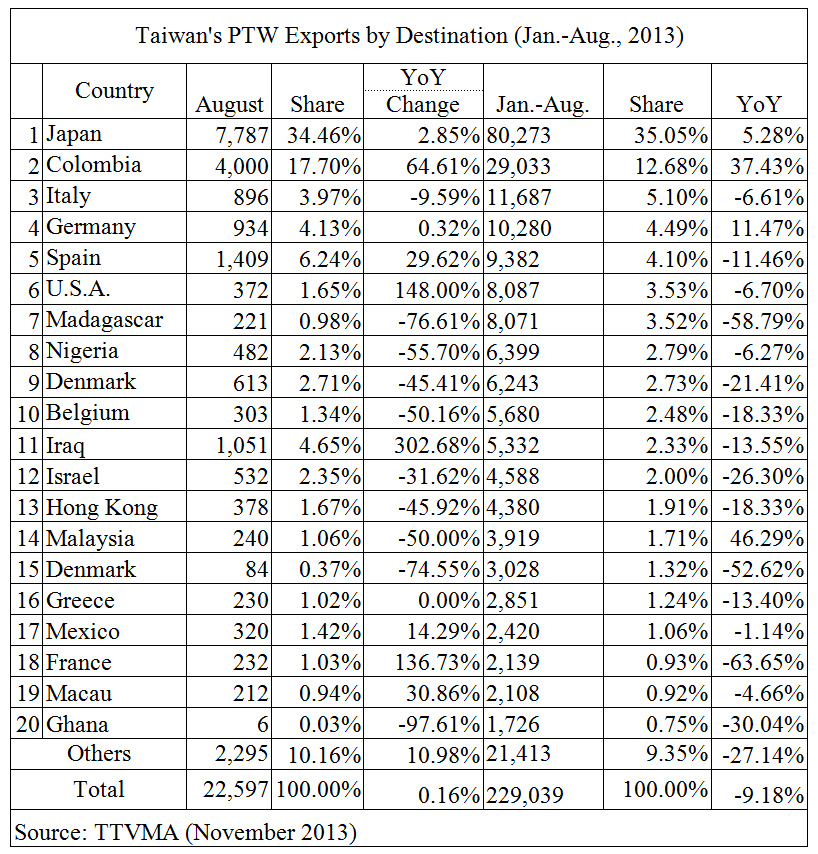PTW Sales in Taiwan Up, Exports Down in 2013
2013/12/16 | By Quincy LiangManufacturers look to South America to make up for falling European sales
The market for powered two-wheelers (PTWs) in Taiwan has long matured. Statistics show that in 2013 each 1.54 Taiwan residents owned one PTW, up from 1.91 per PTW in 2001. Ownership on the island has just about hit its ceiling.

Recovering Domestic Demand

In 2010 and 2011 new-PTW sales in Taiwan recovered to 540,000 and 640,000 units, respectively; but in 2012 the volume fell again, to about 607,000 units, as purchases stalled when the government announced fuel price hikes.
In 2013, domestic PTW sales in the first 10 months saw a 6.7% increase from a year earlier, to 561,000 units, and major PTW makers are optimistic about the rest of the year.
PTW Production in | ||||||||
Year | Total Production (10,000) | YoY | Domestic Sales | Ratio | Export Sales | Ratio | ||
Volume (10,000) | YoY Change | Volume | YoY Change | |||||
2005 | 144.7 | -11.4% | 79.4 | 2.7% | 54.8% | 65.4 | -28.2% | 45.2% |
2006 | 142.3 | -1.8% | 74.7 | -6.4% | 52.5% | 67.6 | 3.3% | 47.5% |
2007 | 152.1 | 6.9% | 74.9 | 0.4% | 49.3% | 77.1 | 14.1% | 50.7% |
2008 | 153.9 | 1.2% | 85.8 | 14.4% | 55.7% | 68.2 | -11.6% | 44.3% |
2009 | 102.0 | -33.7% | 47.8 | -44.2% | 46.9% | 54.2 | -20.5% | 53.1% |
2010 | 102.5 | 0.4% | 54.1 | 13.2% | 52.8% | 48.3 | -10.8% | 47.2% |
2011 | 120.6 | 17.7% | 64.0 | 18.1% | 53.0% | 56.7 | 17.3% | 47.0% |
2012 | 109.0 | -9.6% | 60.7 | -5.2% | 55.6% | 48.4 | -14.6% | 44.4% |
2013* | 90.3 | -0.4% | 56.1 | 6.7% | 62.1% | 34.1 | -10.3% | 37.9% |
*January-October Source: TTVMA, ARTC (November 2013) | ||||||||
PTW Exports
Taiwan's exports of PTWs outstripped overall domestic sales for the first time in 2006; but then, in 2008, exports began dropping as the global recession led to falling demand from major markets such as Europe, the U.S. and Japan, to about 500,000 units a year.
In 2012, Taiwan's top-three PTW exporters were Kwang Yang Motor Co. (KYMCO brand), Yamaha Motor Taiwan Co. (Yamaha), and Sanyang Industry Co. (SYM), which shipped out some 207,000, 126,000, and 114,000 units, respectively. Other PTW makers--Taiwan Golden Bee (TGB), Her Chee Industrial Co., and Aeon Motor Co., among others--also exported a portion of their products, such as scooters, all terrain vehicles (ATVs), buggies, UTVs (utility vehicles, or side-by-sides in North America), etc.).
Major Export Markets
As a production base of under-150cc scooters for Japanese brands Yamaha and Suzuki, Taiwan exported 35% of its total PTW production to that country in the first eight months of 2013.
Major PTW makers on the island have been facing increasing pressure from the maturity of the domestic market as well as fierce competition from Chinese makers in the global market and the long-term domination of Japanese brands in Southeast Asia. Latin America, as a result, has become the new frontier for Taiwanese PTW makers.
In the first eight months of 2013, Taiwan's PTW exports to Colombia reached some 29,000 units, a 13% year-on-year (YoY) increase, boosting that South American nation ahead of the U.S. to become the island's second-largest export market.

KYMCO vice president C.B. Ko recently pointed out that his company is very optimistic about increasing shipments to Colombia, and plans to develop region-specific scooter models for it and neighboring nations such as Brazil, Argentina, and Chile. In the future, Ko added, Latin America is expected to pull ahead Europe to become KYMCO's largest export market, taking more than 50% of its exports.
According to KYMCO, many nations in Latin America are experiencing rapid economic development and PTWs are becoming affordable transportation there. High market potential and relatively few assembly factories operated by international PTW brands drew the attention of KYMCO, prompting it to aggressively develop business in that region.
KYMCO exported more than 50,000 scooters to Colombia in 2012, up more than 70% from the previous year, and in 2013 the figure is expected to grow by a further 20% to more than 60,000. As a result, Colombia will replace Italy as KYMCO's largest overseas market.
Currently, about 540,000 new PTWs are licensed in Colombia every year, most of which are gear-shift motorcycles rather than continuous variable transmission (CVT) scooters. Sales of higher-priced scooters there have been rapidly rising in recent years, however, thanks to the construction of better motorways and increasing incomes. In 2013, 30,000 of the 80,000 higher-priced scooters that are expected to be licensed in Colombia will come from KYMCO, making the Taiwanese brand the No. 1 scooter nameplate there.
In addition to Colombia, KYMCO's exports have extended into neighboring Brazil, Argentina, and Chile. Ko says that if the Latin American PTW market continues to grow, his company may find a local partner and set up a joint venture there; alternatively, it may set up a factory in the region on its own to further strengthen its cost competitiveness.
Europe, by contrast, accounted for only 18% of Taiwan's PTW exports in the first eight months of 2013, compared with a record high of 35.4% in 2010. Most of Taiwan's European sales of PTWs go to Italy, Spain, Germany, Belgium, and Denmark.
The Automotive Research & Testing Center (ARTC), Taiwan's main transportation-vehicle testing and R&D institution, believes that sales in the first 10 months of 2013 pointed to recovery in the domestic PTW market. ARTC cautioned, however, that major vendors should not have unreasonably high expectations for further growth over next couple of years. The center urges the government and private PTW makers to jointly map out effective strategies for helping local manufacturers make up their lost exports to Europe, and to develop more new markets for Taiwan-made PTWs. (Dec. 2013)





